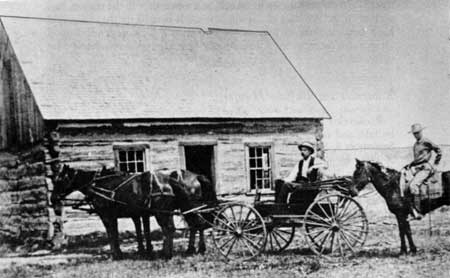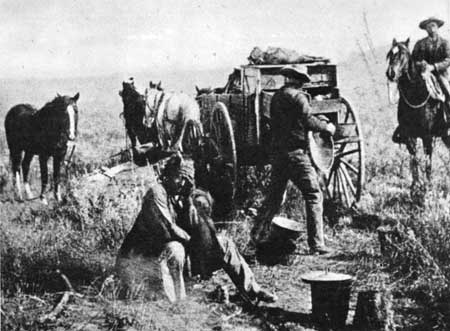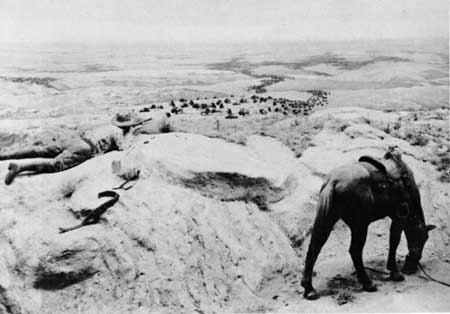|
Theodore Roosevelt and the Dakota Badlands |
 |

Roosevelt's Maltese Cross cabin. S. M. Ferris in
buckboard and S. N. Lebo on horseback. Courtesy E. S.
Foley.
Roosevelt the Buffalo Hunter
Roosevelt's avowed reason for coming to the Badlands was to hunt buffalo and other big game. He arrived there on the morning of September 8, 1883, at the depot of Little Missouri in predawn darkness.
After spending a night in Little Missouri's Pyramid Park Hotel, Roosevelt met Joe Ferris near the cantonment buildings. Ferris agreed to act as Roosevelt's guide and the two set off for the Maltese Cross Ranch. Five miles south of Little Missouri they passed near Howard Eaton's Custer Trail Ranch which was later to develop into one of the first dude ranches in the United States. After fording the river twice they came to the Maltese Cross ranchhouse about 3 miles south of Howard Eaton's place. Here Roosevelt met William Merrifield and Sylvane Ferris. Joe's brother. Roosevelt spent the night in the crude log cabin. The next day the three men continued south along the river to Gregor Lang's place at the mouth of Little Cannonball Creek near the scoria hills 50 miles south of Medora. Lang and his son Lincoln had arrived there from Scotland that spring to operate the Neimmela Ranch for Sir John Pender.
While utilizing the ranch as headquarters for his buffalo hunt, Roosevelt spent several evenings with Gregor Lang discussing politics and prospects for the cattle industry in the Badlands. Meanwhile, his search for buffalo was beset with many disappointments. After a week of hunting in almost continuous rains, Roosevelt and Joe Ferris discovered fresh buffalo tracks which they followed through the rough Badlands. Finally they came upon an old buffalo bull which galloped speedily away. Several miles of hard riding in pursuit brought them out of the Badlands onto the prairie. In the afternoon they sighted three old bulls, and dismounted. Roosevelt crept to within 150 feet of one of them and fired. Although he hit the buffalo, it raced off seemingly uninjured. The chase continued for another 7 or 8 miles when they finally overtook the bull. Rough ground and the speed at which they were riding caused Roosevelt to miss a shot from close range, and the animal got away.

The Maltese Cross chuckwagon. Courtesy
Houghton-Mifflin Co.
The discouraged hunters camped for the night. The next morning they renewed the hunt and soon sighted several buffalo. Because of rain and cold, Roosevelt missed again and the whole group thundered away. The two men spent another rainy, miserable night on the prairie. But Roosevelt continued doggedly in the hunt and shortly after noon of the third day the hunters again came upon buffalo tracks. Roosevelt approached within 50 yards of a large bull and, before the animal disappeared over a ridge, poured three shots into him. The young hunter could scarcely contain his joy when he found the bull dead in the next gully.
Not fan from where Roosevelt hunted, the only sizable buffalo herd then left in the world was making its last stand. At the beginning of 1883 about 10,000 buffalo ranged south of Dickinson near the Rainy Buttes and the headwaters of the Moreau and Grand Rivers. As the year progressed, slaughter by white hide hunters reduced the herd to about 1,200. At that point James McLaughlin, superintendent of the Standing Rock Indian Agency, authorized the Sioux Indians under his authority to participate in the hunt. Between September 14 and October 23, 1883, most of the remaining buffalo were quickly killed.
The town of Sully Springs (2 miles from the South Unit of the park) was one of the most important shipping points for hides on the line of the Northern Pacific Railroad. One of the last shipments of buffalo hides on the Northern Pacific was from Dickinson in 1884. That year about 250 buffalo were sighted 7 miles south of Medora. Soon only bleaching bones were left on the prairie. For several years these towns did a thriving business in buffalo bones which were shipped east to be converted into fertilizer. As the great buffalo herds were destroyed, domestic cattle began to take their place on the vast open range.

Buffalo hide hunter. Photo of a diorama in the
Scotts Bluff National Monument Museum. Courtesy Downey's Midwest
Studio.

|

|
|
Last Modified: Sat, Jan 17 2004 10:00:00 am PDT |


